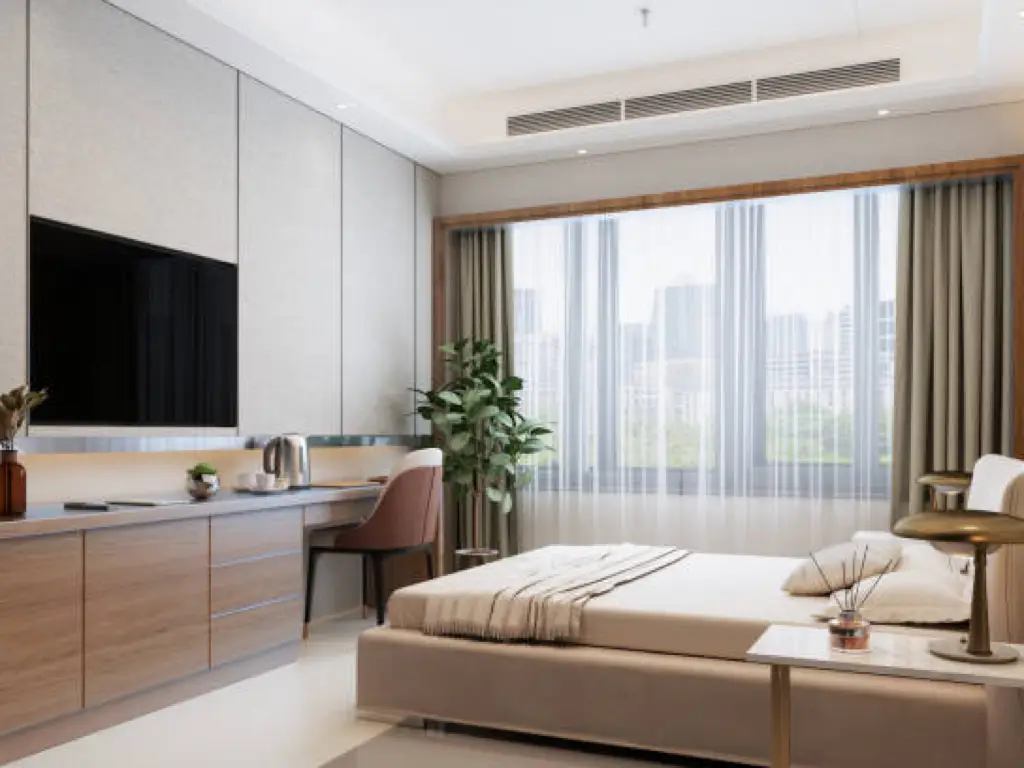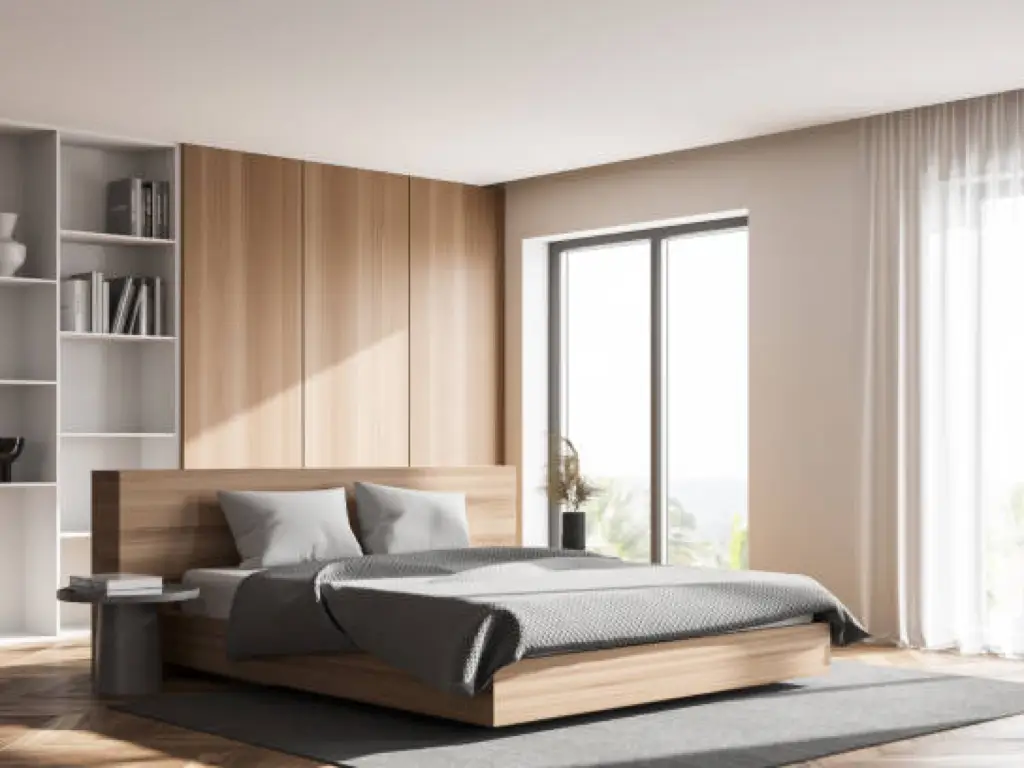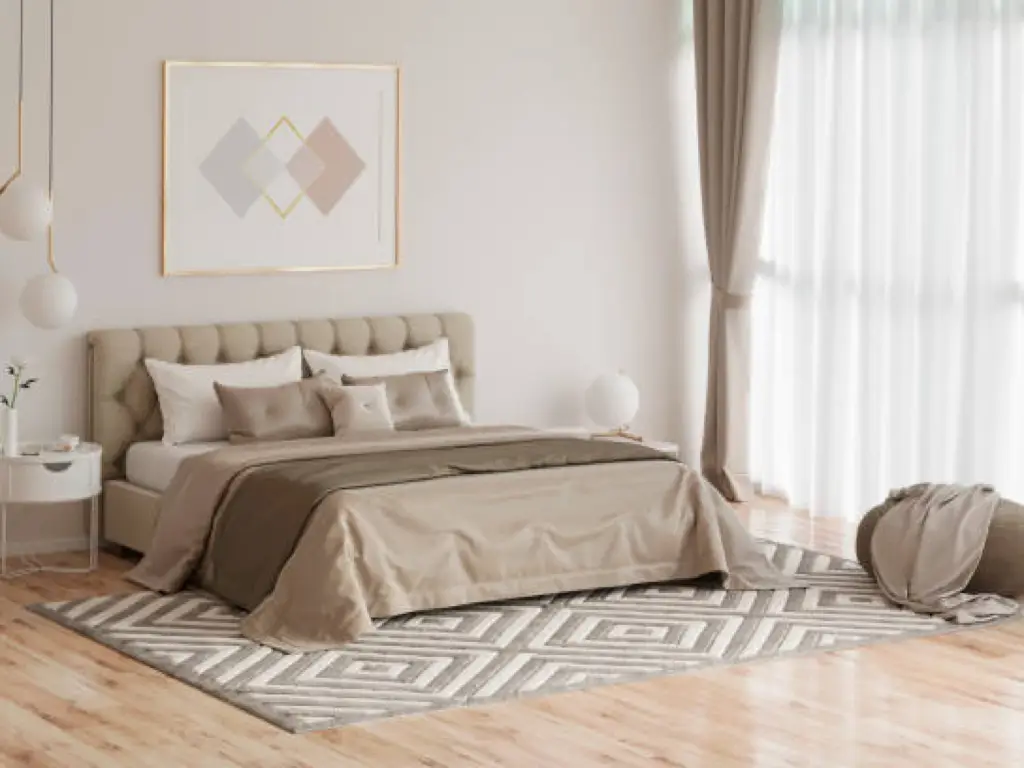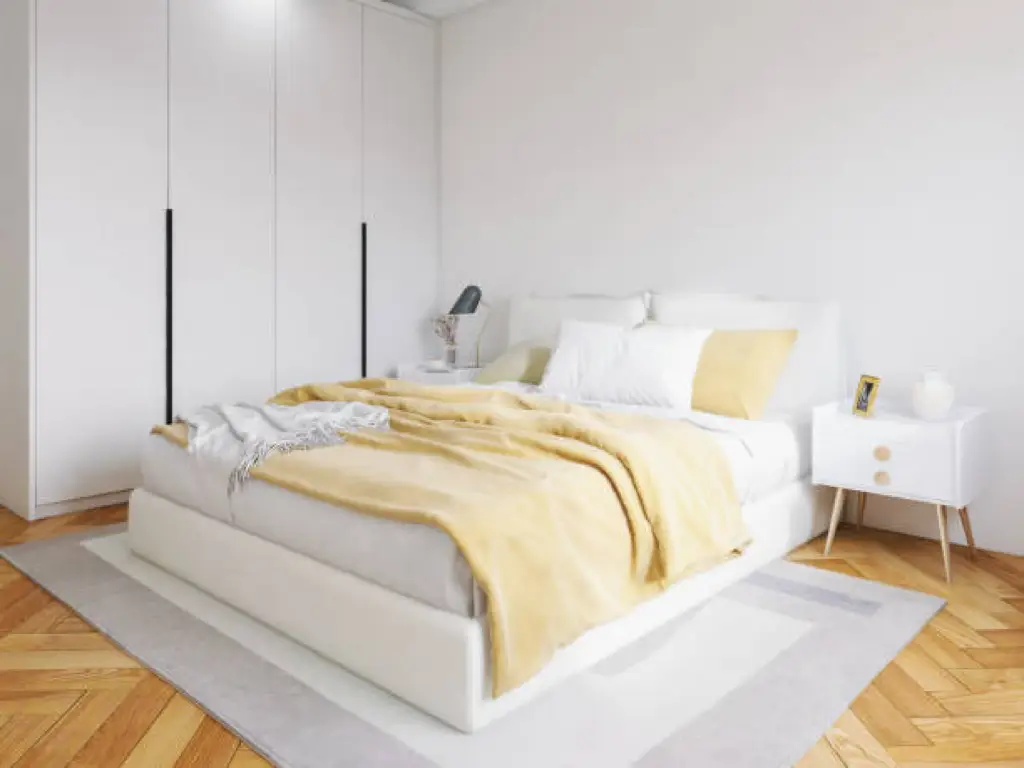Planning your bedroom layout is a critical aspect of designing your living space. It’s about more than just aesthetics; the right bedroom layout can enhance the functionality of the room, increase ease of movement, and invite a sense of calm and relaxation. By paying careful attention to your bedroom furniture layout and considering the placement of each item, you can optimize the use of space, create a pleasing flow, and highlight the unique architectural features of your room. Explore these bedroom ideas to inspire your own design and create a space that reflects your personal style and preferences.
Foundational Elements of Innovative Bedroom Layouts
A central component of an innovative master bedroom layout is the intentional positioning of foundational furniture pieces such as the bed, dresser, nightstand, rugs, and any other significant elements, like a fireplace or TV. Each piece’s placement is crucial in defining the room’s flow and making the space feel balanced and well-coordinated. Also, it’s essential to remember that the goal is not just to make the room look good – it should feel cozy and homey.

How to Arrange Bedroom Furniture?
When selecting the optimal bedroom layout for your home, it is crucial to take into consideration several factors. These include the size and shape of the room, the placement of windows and doors, as well as your personal preferences. The arrangement of your bedroom fixtures holds a profound influence over your overall experience within the space. Therefore, it is of utmost importance to create a layout that not only maximizes the available space but also promotes and enhances relaxation while catering to your specific needs and lifestyle. Ultimately, the goal should be to cultivate a balanced and harmonious atmosphere that cultivates a sense of tranquility and peacefulness.
The Bed: Centralizing Harmony in Your Bedroom Setup
Being the largest furniture piece in your bedroom, the positioning of your bed sets the vibe for the room. If your room is square in shape, you’ll likely want to place the bed in the center as an anchor, thus creating an immediate sense of balance. However, a small bedroom might require a corner placement to maximize sleeping space. When designing your bedroom, it’s important to consider the floor plan to ensure optimal placement of your bed with a headboard. Additionally, it’s crucial to take into account the square footage of the room to determine the best positioning for your bed.
| Near the Doorway Bed Placement | Strategically positioning your bed alongside the doorway not only leverages room features but also optimizes traffic flow, making movement within the room feel more natural and uncluttered. It’s a good choice. |
| Off-the-window Bedrooms | Placing your bed adjacent to windows can allow for effective use of natural light and incorporate feng shui principles. In smaller bedroom layouts, the natural light can give the illusion of enough space, while highlighting the bed’s prominence in the room. Interior designers often recommend this placement to optimize the overall design and functionality of the bedroom at the end of the day. Additionally, creating a cozy sitting area near the window can provide a relaxing space for reading or enjoying the view. |
Optimal Corner Design for Dressing Tables: Illuminating Your Space
A well-placed dressing table not only enhances functionality but also offers an opportunity to bring style and elegance to your bedroom layout. Placing the dresser in a way that allows for ample natural light can make getting ready a more delightful experience, accentuating the cozy feeling in the room.
Innovative Rug Use in Decor: Promoting Balance and Fluidity
In any bedroom layout, large rugs can play a significant role in bedding. Besides adding style and color, they can anchor a room, promoting a sense of balance and coherence. Plus, they seamlessly connect different elements like the bed, nightstand, and dresser, contributing to a smoother flow.
Ideal TV Positioning: Enhancing Bedroom Viewing Comfort
Balancing TV placement in bedroom and living room layouts is crucial for both aesthetic and practical considerations. Placing your TV at a height and angle that ensures comfortable viewing from the bed can enhance the overall comfort and functionality of your bedroom layout.

Perfecting Fireplace Placement: Achieving a Warm Bedroom Atmosphere
In bedrooms graced with a fireplace and a walk-in closet, optimizing its position as a focal point can offer a warm and inviting ambiance. Putting a comfy chair and a small side table nearby can create a cozy reading nook for those colder months. This versatile and inviting addition truly elevates your bedroom layout.
Mastering Nightstand Placement: Emphasizing Convenience in Your Bedroom
The nightstand, also known as a bedside table, is another integral and practical piece of furniture in bedroom layout design. Proper positioning ensures your essential accessories are within reach of the bed, offering a high level of convenience.
Now, with the foundation firmly in place, let’s delve into resolving some common concerns and answer your most asked questions regarding bedroom layouts.
Which bedroom furniture layouts are best to enhance natural lighting?
Lighting, particularly natural lighting, plays a significant role in creating a comfortable and welcoming bedroom environment. To make the most of natural light, position your bed parallel to your windows, allowing the sunlight to evenly distribute across your room. Keeping the area around your windows clear will also maximize light penetration. Regularly cleaned windows and mirrors will further reflect natural light into the room, lighting up dark corners and creating an illusion of a larger, airier vanity space. Adding sconces to your bedroom can also enhance the overall lighting ambiance and provide additional sources of light when needed.
Which Bedroom Arrangement Idea is Best for a Bedroom with an En-suite Bathroom?
Designing bedroom layouts with an en-suite bathroom and a guest room provides both a challenge and an opportunity. An ideal layout places the bed away from the bathroom door, maintaining a separation between the relaxation and functional spaces of your room. Installing a sliding door can also save some space and offer increased accessibility and convenience.

Ingenious Use of Bedroom Alcoves: Reimagining Storage Options
Maximizing storage in a small bedroom layout requires creativity and meticulous planning. Despite its challenges, numerous storage solutions ranging from dual-purpose furniture, strategic placement, and wall storage to inventive closet hacks can offer organized, clutter-free spaces. The key is to look beyond traditional methods and reinvent the allocated spaces for functionally versatile and aesthetically pleasing storage ideas.
Alcoves or recesses found in some bedrooms can often become an interior design challenge. Nevertheless, these seemingly awkward spaces can be transformed into beneficial storage solutions that can amplify the room’s layout, function, and appearance.
Custom-Built Storage Solutions for Alcoves
Custom-built storage solutions such as shelves, cupboards, or dressers tailored for your bedroom layout’s specific dimensions can be a fantastic way to create practical storage. While these designs may require a higher initial investment compared to other pre-made alternatives, they seamlessly blend with your interiors and make efficient use of every square inch of available space.
Ideal for storing books, personal artifacts, or decorative items, custom-built shelves can help free up floor space, consequently making your room appear larger and airy.
Crafting Nooks in Alcoves
Want to add charm and function to your bedroom layout? Convert an alcove into a cozy reading nook or a private workspace. Surrounding the nook with built-in storage cabinets or shelves can provide plenty of room for storing books, office supplies, or personal items. The addition of a well-proportioned desk, chair, and task lighting will further enhance its functionality and comfort.
Window-Positioned Alcove Storage
If your alcove is located by a window, you’ve hit the storage jackpot. Window-positioned alcoves could host dressing tables, desks, or window seats featuring built-in storage beneath. The natural light streaming in makes the alcove a functional, well-lit, and pleasant area.
The same principles can apply if the alcove is large enough to accommodate a wardrobe or tall storage unit. These taller pieces benefit the often-underutilized vertical space, providing plentiful storage while forming an appealing feature around a window in your bedroom layout.
Bringing forward innovative bedroom layout ideas for storage will not only save precious space but contribute greatly to a functional, organized, and tranquil living space. Craft your room with mindfulness, keeping in mind your specific needs, preferences, and the unique features that your room presents.
Is It Possible to Incorporate a Workspace into My Bedroom Layout?
Including a home office setup in your bedroom arrangement can appear challenging initially. However, with smart placement and thoughtful organization, you can create a practical workspace without infringing on your bedroom’s tranquility. Consider designating a separate corner away from your sleeping quarters for your workspace, furnished with a compact desk, chair, and a few shelves for convenience. Utilize a room divider or screen to visually demarcate the workspace from the rest of your bedroom, preserving a focused working environment while maintaining a balanced bedroom layout.

What to Avoid When Planning Your Bedroom Layouts?
While designing your bedroom layout, there are potential pitfalls to avoid. Choosing a bed size too large for your room can make your space feel cramped and out of balance. Avoid blocking natural light sources with bulky furniture and always leave sufficient space around your bed for easy movement. Keeping the layout clutter-free should be a priority for all bedroom layouts, promoting a sense of calm and organization.
Conclusion
Designing perfect bedroom layouts is a blend of practical considerations and personal style. While the placement of fundamental elements like the bed, dresser, and nightstand are primary to the bedroom arrangement, taking into account aspects such as natural light, storage solutions, and potential workspace can lead to maximum utilization of your space. Avoiding common mistakes will bring you closer to crafting your ideal bedroom, where each piece complements the others, creating the most functional, comfortable, and visually pleasing environment possible.
